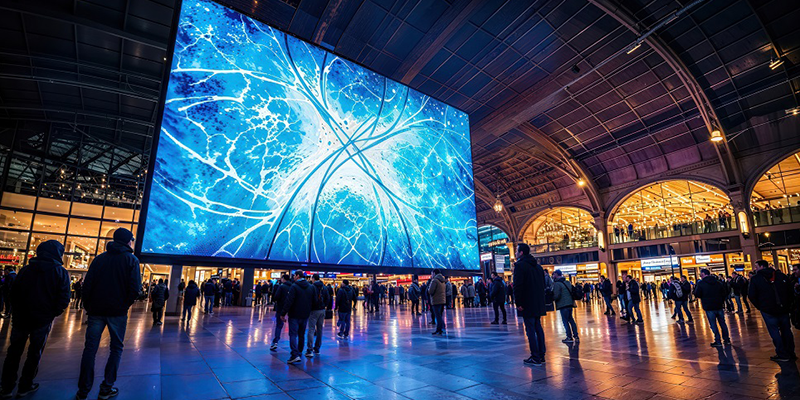
In the last year, event organizers have been focusing on additional ways to integrate digital signage to control crowds and increase personalization for attendees at larger venues. Now, with many industries focusing on technological trends like AI, smart system connectivity, and sustainability, event organizers have even more promising developments to look forward to. Here’s what you can expect from the digital signage industry for 2024 and beyond.
Keeping Up with Digital Signage Trends
Of course, the most familiar usage of digital signage is probably to offer dynamic advertising opportunities for sponsors. Having digital signs means you can update content throughout the event to highlight different messages or promotions, adding value to sponsorships and enhancing the attendee experience with relevant offers. Today, advances in software that has the ability to mix in programmatic advertising content with the venue’s regularly scheduled content has allowed venues to recognize even more revenue from their digital signage networks.
Programmatic advertising involves the use of software to sell and display ads in real time without human intervention. By incorporating these ads into the regular flow of content, such as information about events or promotions, venues can capitalize on viewer engagement more effectively. This strategy ensures that the advertising content is relevant and timely, increasing its impact and value.
Today, signs can even change ad content and sequencing dynamically using AI. Soon, you might even occasionally see some fully AI-generated images and text making their way onto display screens, though widespread adoption at scale is likely still far off. Whether AI in signage will be successful will depend on how well companies review the content creation process to ensure images are acceptable and text is accurate.\
A more practical use of AI in the near future will be for monitoring screens to ensure the right content is playing at any given time. Another use could be dynamically changing content based on real-time info: for example, monitoring line lengths in venue food halls to keep visitors informed of wait times or to guide visitors to stands with shorter lines.
Also in development are digital signs that connect to smart systems as part of what is called the Internet of Things (IoT). With IoT, you can expect to see more companies integrating digital signage with smart sensors. For example, a digital sign with a proximity sensor can run an attract loop – a repeating sequence of content designed to capture the attention of passersby – to draw attendees in from a distance and then change to something more relevant like an event schedule or wayfinding when the visitor approaches the screen closer.
The digital signage industry is also working to reduce its carbon footprint, particularly at large events that may require a lot of screens running simultaneously. This includes incorporating energy-efficient LED technology to replace traditional LCD screens as well as developing solar-powered digital signs. Of course, digital signage already reduces the need for paper-based communication and promotional material, but providers are constantly looking for more eco-friendly screen components and ways to reduce energy consumption.
Making the Most of Technology
Of course, the success of these new trends and technologies lies in effective implementation.
Although AI presents many opportunities for event organizers, content creators should focus on gathering and processing more intelligent data about their audiences to make better decisions around what content to deploy.
For example, you can use AI to process attendee registration information to explore the demographics of your audience and adjust advertisements accordingly. You can also use AI to process engagement data and provide stakeholders with real-time information around how well their content is performing.
IoT Connectivity
As for IoT, there are a couple important things to keep in mind when you enable IoT connectivity for your digital signs. IoT devices and sensors will generate a lot of data you might be able to use to optimize future events. For example, touch sensors can tell you about how users are interacting with your content and proximity sensors can monitor traffic flow. But with all that data, you’re going to need to be able to process it all, which may mean a greater commitment to data analytics than you might be used to.
Also, keep in mind that when you employ IoT and what will likely be a large number of digital sensors, your security risks increase as the attack surface gets larger. In other words, the more internet-connected devices and sensors you have, the more careful you need to be about protecting your system from cyber attacks.
Energy Efficiency
On the topic of energy efficiency, again, LED screens use 90% less energy than traditional screens, but there is certainly more work to do. You can also potentially leverage e-Ink technologies. These screens typically use less energy because once an image has been placed on the screen, the display retains that image without using extra power until the image needs to be changed. This is in contrast to a standard LED screen, which uses power to keep the image on-screen. In the future, you’ll likely also be able to use displays that automatically adjust brightness to lower levels to save on electricity.
Final Thoughts
Digital signage has a clear place in the future of large events. When you implement the latest developments strategically, they’ll help make large venues into smart, energy-efficient, responsive environments that adapt to the needs of each visitor. As the technology continues to advance, we can expect to see even more innovative applications within the event industry.
(April 23, 2024). Christian Armstrong – Commercial Integrator. Retrieved from https://www.commercialintegrator.com/insights/digital-signage-at-large-events-a-look-ahead/133494/
